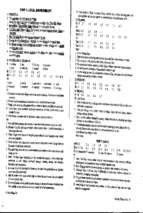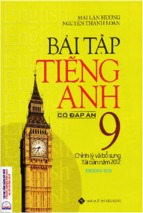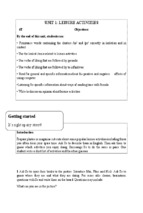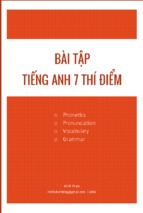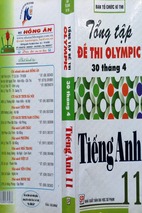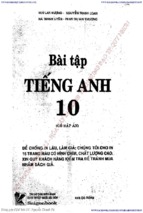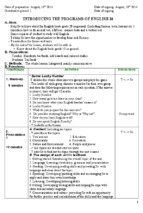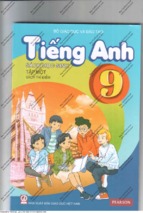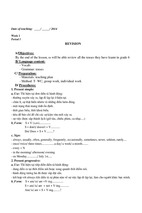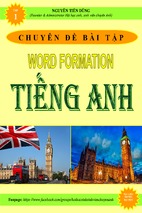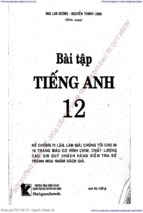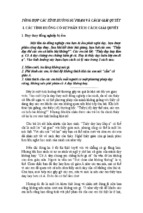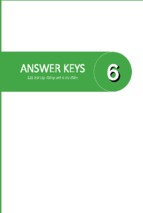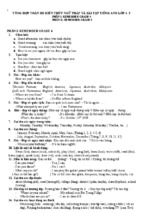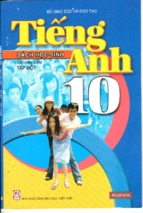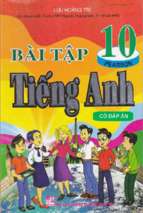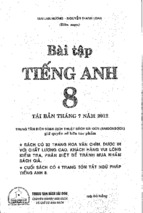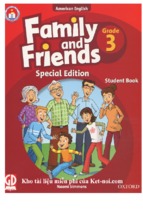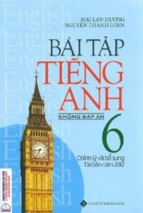Teaching reading through the integration of related multi- subjects
PART A: INTRODUCTION
1. Why was the research paper written?
Nowadays, Vietnam, on the process of the international integration and
cooperation, has been expanding the relations in many areas and creating
fundamental premise for industrialization and modernization. The premise, in
its turn, has made Viet Nam confident to join international life in both scope
and scale. English is a powerfully communicative tool that helps to make
these relations better. It is widely used in such a variety of areas as science,
international business, information technology, transportation, and so on.
Seeing how important English is, the Ministry of Education and Training has
been carrying out the renovation in English books with the communicative
method focusing on teaching four skills as listening, speaking, reading and
writing. These skills are taught integrally by the other language components as
grammar or structure, vocabulary and pronunciation.
Currently, with the project of comprehensive renovation process in the
curriculum and books adopted by the Congress, the Ministry continues to
order teachers to make reforms in teaching methods and testing, assessing to
meet the trend of developing students' ability. It is for this goal that the
integration of various subjects in teaching in schools has been reinforcing and
encouraging. English is one of the school subjects that is in need of this
method. English teachers, therefore, have to change their traditional teaching
method "mono-subject" to the new one "related multi-subjects". This aims at
training a future generation to be more skillful and to be able to have a more
comprehensive knowledge.
1
Teaching reading through the integration of related multi- subjects
Furthermore, not only teachers but students themselves can see the fact that all
the knowledge in life is related to each other. School subjects are different
from each other but connected and supportive during the process of English
teaching. Only the new approach "Integrating many subjects into teaching
English" is an advanced method suitable for the current time and necessary to
both teachers and learners.
Hence, being a teacher of a high school, especially a school in a remote and
mountainous area, I do have much care for the questions “The renovation of
teaching method”, “What can I do to make Reading lessons … less or even
not boring?", "What can be done to help students have a wide range of
knowledge when learning English?" and "How can students get more
information or details about Math, Chemistry, Geography and ... from an
English lesson?". With such questions and thoughts, based on my experience,
I wish to introduce the method which I have been using with the highest result
named "Teaching reading through the integration of diverse subjects"
2. What is the actual situation of teaching and learning English? and who is
the study for?
Most of the English learners understand that English language has been
playing a leading role in communication in every single aspect of the world.
Especially since Vietnam integrated with the world, there have been influences
of the English language on the people’s business and educational access.
These learners really want to communicate outdoors; they need English as a
means of communication. They are motivated and always active in learning.
2
Teaching reading through the integration of related multi- subjects
Additionally, a number of positive students who are quite modern humans can
keep pace with the latest information, changes. Realizing the necessity and the
importance of the reforms, they immediately update it for themselves. By
providing learning opportunities beyond the traditional classroom, students are
able to experience a much broader spectrum of knowledge and skills
necessary to gap the transition from school to work, from school to
community, or from school to further educational endeavors.
However, there are still some different ideas from the rest in schools. Some
think English is a huge pile and complex chain of knowledge, which makes
them confused and embarrassed to find out the best ways to learn it and it is
not easy at all. They always have difficulty remembering what a language
means, and sometimes they can’t remember how to make a correct utterance,
don’t know how to set up a structure grammatically, and even forget it. For
them, it is too much to be able to digest all.
Yet, many teachers still apply traditional methods to teaching. They introduce
the language mechanically and pay no attention to the thoughts, opinions and
needs of today's students. With no intention, they make their students become
out of date and out of the new approach of teaching and learning language.
Teachers control all activities of students and students become completely
passive in the classroom. Consequently, students lose not only their activeness
but their creativeness, which makes the lesson worse.
Thus, this research, as I believe, points to the power of teaching and learning a
variety of involving subjects. It will help students engage in challenging
communication and meaningful learning. By using the integrated knowledge
that foster creativity, flexible thinking, problem solving and real life
3
Teaching reading through the integration of related multi- subjects
applications to gather information, students develop critical thinking and
writing skills. The integration of diverse subjects invites inquiry, construction,
communication, and expression. This research also supports demands that
educators prepare our young people to become independent and life long
learners. In this sense, the majority of suggested activities presuppose that the
students acquire the necessary learning skills for a given activity on their own
and not through orthodox methods of skills delivery. The teacher will have to
adopt the role of a resource person who encourages independent learning.
3. How is the research paper organized?
This research paper has five parts:
Part A: Introduction
Part B: Development of teaching reading through the integration of
related multi-subjects.
Part C: Demonstration of a typical example using the integration
of related multi-subjects in teaching reading.
Part D: The results and the effect of the study application
Part E: Conclusion
Despite much time and care have been given to writing this research paper, the
research paper at which I have worked very hard to make it as best I could, I
realized I could hardly make it to perfection without any shortcomings and
mistakes. I gratefully acknowledge all the respectable professors, the fellowteachers, the readers who have contributed to my research paper with
suggestions, criticisms, and information and help me have a better research
paper for the next time. Appreciation is also elicited to the pilot teachers who
4
Teaching reading through the integration of related multi- subjects
will field test and make suggestions to its merit as a valuable and viable
teaching resource.
PART B: DEVELOPMENT
TEACHING READING THROUGH THE INTEGRATION OF RELATED
MULTI-SUBJECTS
1. Theoretical background of the integration of diverse subjects
Teaching through varied subjects results from the need of teaching goal
"develop students' ability" which strongly ask them to apply the knowledge to
solving true-life problems. When they solve such the factual things of either
physical study or social one, the mixed information becomes absolutely
useful.
Definitions
What is integration? It is the act of combining or adding parts to make a
unified whole. To integrate things is to put them together to form something
new.
Integrated teaching is to bring related educational points in the process of
teaching like the morality integration, the life-skills integration, etc.
And the figure below shows how various subjects are combined in the
teaching process.
5
Teaching reading through the integration of related multi- subjects
Teachers have to
determine
ITEM
what
knowledge
is
ITEM
ITEM
related to two or
even
more
two
subjects
to
convey to learners.
This
prevents
learners
ENGLISH
than
INTEGRATED
ITEMS
ITEM
HISTORY
ITEM
MATHS
from
repeatedly getting
the
same
knowledge
when
ITEM
ITEM
ITEM
they sit for other
subjects.
Across the nation there has been a growing interest in involving multi-subject
integration as an approach to teaching in which this subject leverages learning
in other subject areas such as science, language arts, mathematics, and social
studies, etc.
Related Multi-subject Integration is
an APPROACH to TEACHING
in which students construct and demonstrate
UNDERSTANDING
through a CERTAIN FORM.
Students engage in a
CREATIVE PROCESS which
CONNECTS a certain form and another subject area
and meets EVOLVING OBJECTIVES in both.
6
Teaching reading through the integration of related multi- subjects
(deduced from “Defining Arts Integration” by Lynne B. Silverstein and Sean
Layne © 2010, The John F. Kennedy Center for the Performing Arts)
Rather, related multi-subject integration is an approach to teaching that is
embedded in one’s daily practice. An “approach to teaching” refers to how
something is taught rather than what is taught. Every teacher has an approach
to teaching, whether or not they are aware of it.
Approaches fall along a continuum from traditional, teacher-centered
instruction to more progressive, student-centered instruction. Ultimately, our
approach is based on our beliefs about how students learn. As an approach to
teaching, related multi-subject integration relies heavily on the progressive,
student-centered end of the continuum.
This approach to teaching is grounded in the belief that learning is actively
built, experiential, evolving, collaborative, problem-solving, and reflective.
These beliefs are aligned with current research about the nature of learning
and with the Constructivist learning theory. Constructivist practices that align
with related multi-subject integration practices include:
Providing active hands-on learning with authentic problems for
students to solve in divergent ways
Arranging opportunities for students to learn from each other to
enrich their understandings
Engaging students in reflection about what they learned, how they
learned it, and what it means to them
Using student assessment of their own and peers’ work as part of the
learning experience
7
Teaching reading through the integration of related multi- subjects
Providing opportunities for students to revise and improve their
work and share it with others
Building a positive classroom environment where students are
encouraged and supported to take risks, explore possibilities, and
where a social, cooperative learning community is created and
nurtured
Students construct and demonstrate
UNDERSTANDING …
understand (vt.) – (1) to get or perceive the meaning of; to know or grasp
what is meant by; comprehend (2) to gather or assume from what is heard;
to infer 3) to know thoroughly; grasp or perceive clearly and fully the
nature, character, functioning, etc. (4) to have a sympathetic
rapport with
Constructing understanding of one’s world is an active, mind engaging
process. Information must be mentally acted upon in order to have meaning
for the learner.
Related multi-subject integration provides multiple ways for students to make
sense of what they learn (construct understanding) and make their learning
visible (demonstrate understanding). It goes beyond the initial step of helping
students learn and recall information to challenging students to take the
information and facts they have learned and do something with them to build
deeper understanding.
“In the class students have central and active roles as meaning makers.
This role demands that they not only acquire knowledge but they develop
8
Teaching reading through the integration of related multi- subjects
the capacity to reflect on what they are learning and to use it as they
interpret and create their own works:
Students can and should have opportunities to construct and demonstrate their
understandings in various ways. Nationwide, classrooms have become, and
continue to become, more culturally, economically, and academically diverse.
Students engage in a
CREATIVE PROCESS…
creativity (n) - an imaginative activity fashioned so as to produce
outcomes that are original and of value
The heart of related multi-subject integration is engagement in the creative
process. Related multi-subject integration requires that students do more than
repeat (a song), copy (an art project), or follow directions. They must create
something that is original and of value.
The creative process in the involving multi-subjects is a process not a single
event. It includes many interacting
phases and each phase is related to
every
other.
There
are
many
descriptions of the creative process. The
one provided here is a synthesis of
ideas from many different sources. In
this diagram, the process is made
visible as five open circles. Students
imagine, examine, and perceive. They
explore, experiment, and develop craft. They create. They reflect, assess, and
9
Teaching reading through the integration of related multi- subjects
revise, and share their products with others. Arrows indicate the ways one can
enter the process and the myriad ways the phases interact.
When students engage in the creative process, they produce original work that
communicates their ideas, insights, points of view, and feelings. The creative
process can be “messy.” It is difficult to predict what will happen, be
discovered, or emerge during the process. Learners engage in inquiry and
experimentation as opposed to following rigid, step-by-step rules. Some ideas,
once explored, do not work well, while other ideas that were not originally
considered, may surface as the perfect solution.
If teachers are overly concerned with a “neat” process and product, they tend
to make the creative choices for students and direct the outcome. In these
cases, the creative process is present, but only for the teacher. It is the
teacher’s or teaching artist’s responsibility to set a creative problem or
challenge for students to solve, but not to take over and solve the challenge for
the students.
…which CONNECTS
an a certain subject and another subject area…
connect (v) - to join, link, or fasten together; unite or bind
A distinguishing aspect of related multi-subject integration is
its
interdisciplinary connections.
Connections are made between a specific subject and a specific curriculum
area. Connections can also be made between a specific subject and a school’s
concern or need. Schools often identify a focus for improvement that is
10
Teaching reading through the integration of related multi- subjects
sometimes outside the formal curriculum. For example, the reading text can
connect
to
school
concerns
such
as
character
education/bullying,
collaboration, habits of mind, or multiple intelligences.
By engaging in learning in one subject, learning in the other subject is
reinforced and extended, and vice versa. Rather than imagining connections
as two intersecting lines, mutually-reinforcing connections function as a cycle.
... and meets
EVOLVING OBJECTIVES in both.
evolve (v) -to develop gradually
This final part of the definition underscores two ideas. First, related multisubject integration requires teachers to set objectives in both a certain subject
and the other subject area. The dual objectives are balanced; students are
accountable for significant learning in both subjects.
Advantages and disadvantages
For students
Integrated themes are known to be true or genuine so it is quite interesting and
attracts students' attention, which will predominantly motivate and encourage
students to learn. Absorbing these themes, students have a chance of using the
newly-created knowledge to deal with factual situations instead of
memorizing the knowledge mechanically.
For teachers
11
Teaching reading through the integration of related multi- subjects
Teachers, at first, have some difficulties because of searching everywhere for
the details and information of other subjects. Understanding other subjects is
limited. However, this problem will be able to be resolved due to the two
following reasons:
Firstly, during the process of teaching, teachers themselves have to give
their students the knowledge involving in other subjects. As a result,
they are able to receive a deep understanding of integrated knowledge.
Another reason is connected to innovating contemporary teaching
method. Teachers' role has completely changed. No longer have they
been centered in classrooms. They have been organizers and conductors
learners' activities inside and outside the class. So teachers have
opportunities to promote mutual cooperation in teaching.
Therefore, this combination of various subjects helps to foster and improve
teachers' understanding and pedagogic skills, which has a fully contribution to
the progress of Vietnam's education system.
2. Teaching reading through the integration of related multi-subjects
The days of believing that we could hand informational text or a novel to a
student and assume he or she make full meaning of it on their own is a
teaching mode of the past. Whether we like it or not, regardless of the
content we teach, we are all reading instructors. We need to inspire both a
love for reading and reading stamina in our students.
What can teachers do to achieve this goal?
12
Teaching reading through the integration of related multi- subjects
When designing an English lesson, teachers easily discover to what its content
belongs so as to integrated suitable items.
If the lesson is about geographical names like Unit 6 "An excursion" English
10, Unit 16 "Historical places" English 10, teachers can exploit the
geography, the weather, human characteristics, fauna and flora ... in Hanoi.
(Geography and Biology are mentioned). Students will certainly like engaging
in activities because Hanoi with Huong pagoda, Thay pagoda is the tourist
destination most of them visited.
With the lesson about the marvelous structure of history and culture, Unit 16
"The wonders of the world" English 11, history or geography, arts integration
is fully used. Who built that structure? Where? What is its geographic
location? Is it about any famous historian or historical events? ...
The lessons about sports, Unit 12 "The Asian Games" English 11, Unit 14
"The world cup" English 10, Unit 12 "Water sports" and Unit 13 "The 22 nd
SEA games" English 12 gets much more exciting if teachers skillfully
stimulate students' interest in showing their experience in favorite sports and
talking about the advantages of regularly practicing sports.
Life-skills integration is more and more efficient and competent in such
lessons as Unit 2 "Personal experiences" English 11, Unit 1 "Home life"
English 12. Here students will be able to know how to behave better in bad
situations, what to do to help busy parents.
Even in Unit 5 "Technology and you" English 10, informatics integration, the
way to use culturally social web is imported. The class will be motivated with
the so-called mail, chit-chat or facebook ...
13
Teaching reading through the integration of related multi- subjects
Teachers could also expose students to different kinds of audio, such
as a live recording versus audio recorded in a studio in Unit 12 "Music"
English 10, and then pepper them with questions about the quality of the
sound and how they would create that sound themselves. This can encourage
students to use the problem-solving and critical thinking skills necessary for
engineering. Rap can help students understand historical poetry. Students can
read a passage from a poem and teachers can lead students in a discussion
about how poetry relates to songwriting. Then students can engage in a rap
battle to decipher
In a word, it can be said that teachers can integrate a variety of subjects into
teaching English language. And obviously, the effectiveness of the lesson, the
creativity of learners and the lovers for the lesson is shown in detail. Students
become much more positive and active to present what they know in different
aspects, varied subjects in English classes. To collect this fruit, all English
teachers should notice "The integration is an extremely necessary thing
because it brings a nice outcome to both teachers and learners"
PART C: DEMONSTRATION
A TYPICAL EXAMPLE USING THE INTEGRATION OF RELATED
MULTI-SUBJECTS IN TEACHING READING
Being a teacher of English for many years, I myself have accumulated some of
the so-called teaching experiences beside the previous method. It is the way to
teach by integrating involving different subject into a new one.
Take Unit 16 "The wonders of the world" English 16, Lesson
1"READING" as an example. In this lesson, Math, History, Geography and
Physics are integrated.
14
Teaching reading through the integration of related multi- subjects
Part 1: LEAD-IN
(geography integration)
Item 1: Video clip (wonders of the world)
Item 2: A map (Giza, Egypt)
Questions:
What can you see from the map? (Ss: Giza)
Where is it located?
Part 2: WHILE-READING
(physics integration)
Item 3: Video clip (the process of building the pyramid)
Question:
1. What are the three things used to help people carry big
stones up to the pyramid?
Ss: ramp, roller, water
2. What did people use "ramp, roller and water" to carry the
stones for?
Ss: to reduce friction
Item 3: a photo (reduce friction)
15
Teaching reading through the integration of related multi- subjects
Item 4: a photo (how to measure the height of the pyramid)
(Maths integration)
Questions:
1. How did people measure the height of the pyramid?
(Thalés theorem)
2. Who found out how to measure?
(Scientist: Thalés)
Item 5: a photo of Thalés (give some information about this scientist)
16
Teaching reading through the integration of related multi- subjects
Part 3: POST-READING
(life-skills integration)
Question:
1. Do you think these ancient constructions should be destroyed for
modern blocks of building?
2. What should you do to preserve them?
PART D:
THE RESULTS AND THE EFFECT OF THE STUDY APPLICATION
After using this technique of teaching reading, I have collected considerable
results from the two surveys which I fulfilled in the classes as follows:
1. Collecting students’ opinions about being taught by the integration
of related multi-subjects
A short interview was conducted to find out the attitude and opinions of
students towards the use of this method to teach reading. The interview was
carried out among all the students of all levels. I collected some responses to
the questions below:
Question 1: Do you know what the integration of related multi-subjects is?
Question 2: What are the effects of involving knowledge on you in
learning reading?
Question 3: What are the difficulties in learning with so many subjects at
the same time?
Question 4: Do you want to learn reading with the related multi-subjects?
Here are the students’ responses to the four questions:
17
Teaching reading through the integration of related multi- subjects
Question 1: All of students’ answers were YES. Some students added
that this expression were quite the same to what they thought of them before.
At least, after the lesson, students knew some main features of the process of
integrating many subjects into one lesson.
Question 2: With this question, there were different answers. Student 1
said that she could remember the knowledge in the whole easily for a longer
time after the lesson. Student 2 added that when she did any kind of test, learn
any subjects, she imagined the knowledge provided and tried to recollect her
knowledge. In short, students agreed that the integration of related multisubjects helped them a lot in learning. Moreover, there was one student added
that he felt more enjoyable to learn with this integration because it was new,
funny and creative. He loved showing his creativity in doing the task given by
the teacher.
Question 3: For the next questions, student 4 thought that she was not
good at imagination and summarizing the knowledge. It took her more time to
understand the mixed items and she sometimes misunderstands the items
taught by this way. She couldn’t even draw a certain line of knowledge. So she
came to a conclusion that learning through this way is just impossible. Many
other students just kept silent with this question because they all believed that
the integration brought them more advantages than disadvantages in learning.
Question 4: The last question was to check if students wanted to learn
with the integration of related various subjects, too and was to determine if I,
an English teacher, should use this technique in teaching. “Oh, what a right
choice I have!” I shouted in happiness. Nine out of ten students wanted to be
18
Teaching reading through the integration of related multi- subjects
taught in this way. They even asked the writer to conduct more trial lessons
and they would be willing to take part in those. However, some of these
students added that it was unnecessary to welcome this technique all the time.
They also shared that they wanted to have more time for the lesson so that
they could understand the lesson more.
From the interview, I knew that my method of using the integration of related
multi-subjects to teach had the full support of many students in my school.
2. Using statistics of students’ studying result
Being an English teacher to teach a foreign language which is difficult to most
of students, I have met a number of difficulties in teaching. Here all the
students know almost nothing about English because most of them come from
the schools very far from the centre, many including ethnic minority ones
come from remote villages, they have no condition to learn. Their knowledge
gradually disappears without the teacher’s enthusiastic help. With thirteen
years of experience, I have tried my best to save the situation. I renew my
teaching method with effective techniques. As a result, I have harvested
considerable fruits as follows:
Grade
11
10
Students
(Total)
43
43
126
123
T1/T2
Poor
Weak
Average
Good
Excellent
T1
T2
T1
T2
17
11
105
76
24
17
19
33
2
13
2
12
0
2
0
2
0
0
0
0
Over
average
2
15
2
14
Above is the comparison of students’ learning result in the first test (T1) done
at the beginning of the academic year and the one (T2) in the first-term test.
19
Teaching reading through the integration of related multi- subjects
Obviously there is a noticeable difference between students who were taught
by integrating many subjects into teaching and the ones who were not.
After analyzing the data, I find out that the achievement of the students taught
by my technique is better than that of the one without my technique.
Based on the above statistics and explanations, the achievement in the
experimental class indicated that teaching English using the integration was
effective. Nevertheless, there were still many students who get low marks. I
think that they are really not interested in English and it is difficult for them to
learn the material, because of having no support from their facilities or
because of their lack of awareness of learning English.
PART E: CONCLUSION
Teachers are guides rather than dictators; imposing ideas on students is an oldfashioned teaching method, which is likely to blunt students’ sharpness and
creativeness. Teacher’s guidance or guiding teaching using the technique
mentioned above will work well. An effective technique required flexibility
and creativity. In other words, teaching English using the integration is more
effective than just giving information with "mono-subject", especially in
teaching English. Teachers who process the way to teach with the integration
can create a good atmosphere especially for the students to make them
enjoyable and well motivated in learning English, because of the interesting
features of these various items and different subjects.
Contributions of the study
20
- Xem thêm -

